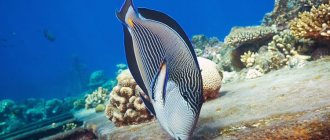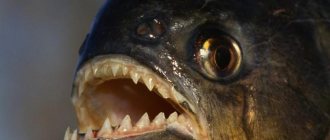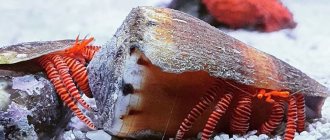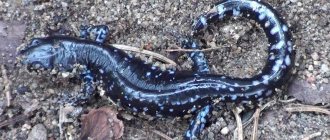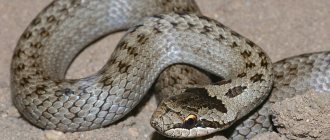Judging by the photo, the angel fish is beautiful, like a real celestial being.
But getting to know this representative of the perciforme order can surprise you, since in reality the ray-finned fish is much more beautiful.
Its large body has a clear trapezoidal shape and incredibly bright colors, which makes exotics popular.
Connoisseurs of underwater fauna are trying to get beauties to decorate tropical aquariums.
Conditions of detention
Angels need a large aquarium of 400 liters or more with a powerful filtration and aeration system. These fish are sensitive to water parameters and are quite difficult to keep. They should not be an aquarium. Suitable conditions for them: temperature +24…+26 degrees, acidity pH 8.1-8.4, salinity 1.020-1.025.
The aquarium needs shelter and free space for these large fish to swim.
Ringed angel Pomacanthus annularis
Reproduction and lifespan
Some species of angelfish cannot breed in captivity. Such specimens are caught from the natural environment. But others are quite ready to reproduce in captivity. Pomacanthus ripen on average in 10-12 months. Their sexual demorphism is not pronounced - males and females are practically indistinguishable. But it is not difficult to identify fish ready for spawning - they stay in pairs away from other inhabitants of the aquarium.
To start the process, you need to create the required conditions: increase the water in the spawning tank to 28-29°C, plant large-leaved plant species there on which eggs will be spawned, and ensure good aeration.
Angelfish can spawn for more than one hour; in the end, it will produce 300-700 eggs, half of which will subsequently be unfertilized. After 7-9 days the fry hatch.
It is interesting that juvenile pomacanthus are fundamentally different in color from adult individuals. Due to the fact that the angels drive their own kind away from their reef, the younger generation can calmly exist side by side with their parents, since they mistake them for another species. This is how nature took care of them.
The differences between an adult angelfish and juveniles are noticeable to the naked eye.
In the right conditions of a well-maintained, mature aquarium, Pomacanthus live 10-18 years.
Reviews about angel fish
Oleg, review of the neon angel of Navarre
A peaceful, calm angel, he began to eat immediately, both artemia and drying. I'm still indifferent to corals. I didn’t get along with the imperial one, so I had to put the second one in the samp.
Olga Rusakovich, review of Apolemichthas three-spotted (Blue-lipped angel)
Beautiful bright colors. Just blinding yellow. It looks especially good if the aquarium has a blue background.
The most boring fish I've ever had. It just floats back and forth. If you use an aquarium not to observe the behavior of fish, but as a background picture, then this fish is ideal for its brightness and unpretentiousness. If interesting fish behavior comes first, then this is not your choice. Since many people start a marine aquarium because of the bright colors, being inspired by posters that usually depict a masked butterfly, this is an excellent alternative to this “hyped” butterfly, because the color is almost the same, and it is much easier to maintain than butterflies.
Oleg, review of the imperial angel (juvenile)
Imperial angel. On the left is the adult form, on the right is the juvenile form.
Well fed, not picky
Disadvantages: Grows quickly, brazen
An extremely bold, fast-growing fish. But she is smart, remembers the owner, the time of feeding - when she approaches the aquarium in the morning, she swims up to the glass, turns around, and slaps her tail on the water with all her might, so that a stream flows along the front glass. Terrorizes everyone in the aquarium, especially the helmon. But it is slow and lazy, it does not chase anyone more than 30-50 cm.
Six-stripe angel (sextriatus) Pomacanthus sexstriatus
Types and their description
The average size of these inhabitants of coral reefs is 20-30 cm, some grow up to 60 cm, the smallest species do not exceed 12-15 cm.
Today, science knows about 85 subspecies of angelfish.
Representatives of the family Pomacanthidae have a characteristic body shape, similar to a rectangle. This visual impression arises from the shortened caudal fin and large, high forehead of the fish.
Royal
A bright and elegant fish that grows up to 25 cm. The royal angel fish has a fancy coloring of contrasting white-blue, dark blue and orange stripes. The tail, pelvic and pectoral fins are yellow, the dorsal end is deep blue, the anal is decorated with a honey-blue striped pattern.
Sinekoltsovy
The fish has a dark copper shade of scales with an interesting pattern in the form of bright blue stripes. This species is considered particularly graceful and is often found in species aquariums, but requires very large volumes.
Imperial
An interesting fish with a dominant turquoise color and horizontal stripes of a contrasting yellow hue. The large beige-fawn head has a dark mask. The dorsal and caudal fins are yellow, the anal fin is orange with neon edging. The imperial angel can grow up to 40 cm.
Angel of Cortez
The young are jet black with yellow and blue stripes. With age, the base color changes to a yellowish olive with thin blue lines and dark specks.
Red Stripe
A miniature species, growing no more than 15 cm in length. The fish has a silver-gray color and is decorated with bright blood-red or orange transverse lines. The dark blue tail and anal fin are outlined with a blue neon line. Paired fins, lips and eye contour are marked in soft orange. This variety requires a good mature aquarium with an established ecosystem containing a large number of underwater plants and small invertebrates.
Pockmarked sea angel
The view is also called semicircular.
Juveniles are painted in blue, white and black tones, but over time the fish acquires a calmer coloring in a greenish-brown tones with frequent specks. In aquariums you can also find black, bicolor, lyretail and other species. When buying young animals, you need to be confident in the breeder, and also know the exact description of the appearance and behavior of the adult.
Summary
- Pisces are close to the spiritual world, so they usually feel and see well the support, help and tips of their Angels, and their prayers are almost always heard and taken into account.
- Pisces has two patron saints - Saint Alexius and Milentius of Antioch. They are also protected by the Iveron Icon of the Mother of God.
- To seek help from spiritual intercessors, Pisces does not have to use special prayers, although, of course, it is possible. If you express your requests and gratitude in your own words, but with sincere faith, then they will definitely be heard.
What to feed
To ensure the full functioning of the pomacanthus, you need to feed it properly. The diet should include components of plant origin - algae, vegetables, herbs. He prefers to eat peeled peas and special sticks that are designed for him. These sticks contain spirulina. It is not recommended to pour dry food into the aquarium. If the fish consume it, it can cause problems with their digestive system. It is better to pre-soak solid food and only then pour it into your pets.
In order for them to satisfy their need for greenery, it is recommended to equip the aquarium with algae. Give protein food thawed. Live protein foods can contain parasites, which negatively affects the health of pets. As protein feed, you can take small crustaceans, squid meat, and shrimp.
It should be borne in mind that sea angels are quite voracious. Therefore, they need to be fed in doses and not overfed. Give food little by little and remove any leftovers after a few minutes. If the food is of poor quality or the living conditions are unfavorable, this will negatively affect the color of the fish. They become dull, begin to get sick and soon die.
It is not recommended to purchase such a pet for a beginner in the aquarium business. Keeping this capricious sea creature requires experience. If conditions are comfortable, the average life expectancy of a pomacanthus is 8 years.
Habitat
Angelfish came to home aquariums from warm tropical seas. In their natural environment, they live among bright coral reefs at various depths. Some subspecies are found even at a depth of about 60 meters. Angelfish live in the waters of three oceans - the Pacific, Atlantic and Indian, and in all the seas of the tropical and subtropical climate zones.
Despite the fact that angel fish belongs to the perciformes family, which are overwhelmingly predators, this fish prefers a varied diet. They feed mainly on zooplankton, algae, sponges, and small invertebrates. Essentially, these angelfish are omnivores. They differ quite a lot in size, their average length is 10-20 cm, but some species can grow up to 60 cm.
The angel fish acquires its bright and unusual color once it reaches a certain size. The babies have a uniform and rather inconspicuous coloring, which contributes to greater survival of the fish in natural conditions. The color change occurs very quickly. Almost within a few weeks, an inconspicuous fish turns into a magnificent beauty in a bright, unusual outfit. Despite the fact that they live in coral reefs, angelfish form quite large groups, by nature they are solitary. Groups exist only to designate and protect their habitat, within which the fish form pairs. Stronger males may have a small harem of 1-3 females, which they carefully protect.
It was the diversity and splendor of the natural coloring of the angel fish that attracted the attention of aquarists around the world to it. And watching them in their natural environment is a fascinating and beautiful adventure.
Feeding
Angel fish is a rather voracious creature, but an omnivore. Therefore, on the one hand, it is easy to feed it, since the fish does not refuse any food. On the other hand, in unnatural conditions it needs to be provided with a varied diet, which will include algae, sponges and small invertebrates. Only then will the fish retain its bright color and feel comfortable.
In specialized stores you can often find ready-made food intended for this type of fish. Buying this food is an ideal option because it is balanced and contains all the necessary components. If you decide to create a diet yourself, then be sure to include crushed sponges and spirulina in the menu.
You need to feed the fish 2-3 times a day, giving the amount of food that the inhabitants of the aquarium can eat at one time. You can also include chopped frozen mussels, shrimp, squid, and even add a little spinach to your home menu.
When feeding, pay attention to whether the food goes to younger individuals and the angels’ neighbors in the aquarium. Gluttonous fish often try to eat more food on their own, and other fish may be left without food. In a cramped aquarium, they may not allow smaller fish into the food at all.


